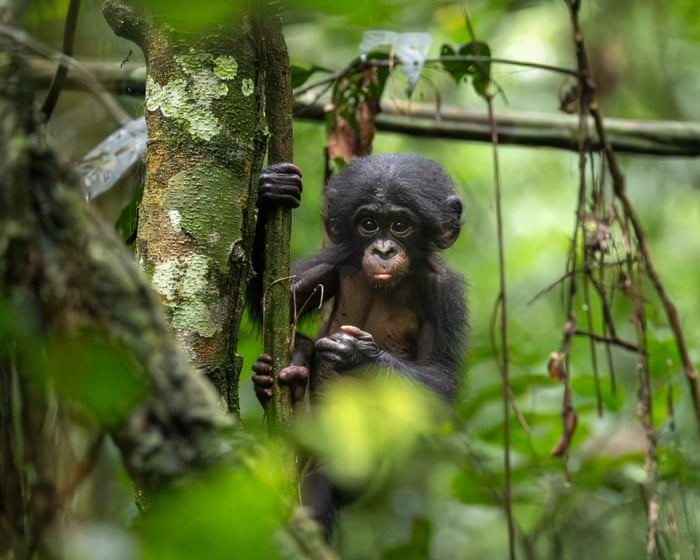In the hazy dawn of the equatorial forest, dozens of large nests are partly concealed by vines and leaves. These are the sleeping quarters of bonobos, high up at 12 meters. After a night of rain, the primates are slow to rise. At 6:30 a.m., the first head appears, letting out a sharp bark. Another figure emerges from its nest of branches, and then another. Within five minutes, the whole group is awake—yawning, stretching, and straightening up. They have fine features, long and slender limbs, and a less stocky build than their closest relatives, chimpanzees.
Bonobos inhabit the left bank of the Congo River, while chimpanzees are found on the right bank, ranging from the Democratic Republic of Congo to Tanzania in the east and Cameroon in the west. The two species split about 1-2 million years ago, likely when some chimpanzees crossed the river during an extreme drought.
These early migrants evolved differently. Chimpanzees developed male-dominated societies with traditions of group hunting and frequent conflicts. In contrast, bonobos have female-led societies that are more peaceful and less aggressive. When researchers began studying them in the 1970s, they noticed that conflicts were often resolved through brief sexual encounters, earning them the nickname “hippy apes.”
Scientific research on bonobos started near the village of Wamba, just north of the equator. Japanese primatologist Takayoshi Kano established the first observation post there in 1973, followed by another at Lomako the next year and a few others. Today, four sites remain active: Kokolopori, LuiKotale in Salonga National Park, Lomako-Yokokala, and Wamba.
Over the past 50 years, studies at these sites have revealed bonobos’ unique traits: females lead social groups, sex eases daily interactions, and they show tolerance, emotional sensitivity, and a remarkable capacity for empathy—qualities once believed to be exclusive to humans.
This year, a study in Kokolopori, published in Science, found that bonobos can combine vocalizations in complex ways, similar to human language structure. “This challenges our assumptions about animal communication and the uniqueness of human language,” says American conservationist Sally Coxe.
In 2002, Coxe helped protect part of the Kokolopori forest through the Bonobo Conservation Initiative, working with the local group Vie Sauvage to safeguard the remaining bonobos and study them with Harvard University.
However, 20 years later, the protected area and research face the same challenges: few roads, no electricity, and crumbling infrastructure. The DRC remains one of the world’s five poorest nations, despite its rich deposits of copper, cobalt, lithium, and coltan. According to the World Bank, three out of four Congolese live on less than $2.15 a day.
“The roads haven’t been maintained since the 1990s, and vehicles can no longer use them,” says Mbangi Aringo, the most senior tracker in the Kokolopori forest.”If we want to sell our crops, we have to carry them on foot or by bicycle,” says a man in his 50s. “If BCI hadn’t paid me a salary to observe the bonobos, I would have become a farmer and struggled to feed my family, or I would have had to hunt in the forest. I had no other choice.”
One of his tasks in the forest is collecting bonobo urine.
Against this backdrop, bonobos—one of the Democratic Republic of Congo’s most iconic species—are increasingly threatened by human activities, especially poaching and deforestation, which steadily shrink their habitat. “We estimate the population at fewer than 20,000 individuals,” says Takeshi Furuichi, research director at Wamba and a professor at Kyoto University. “Perhaps even fewer than 15,000. They are now critically endangered.”
To slow the loss of their habitat, the government and conservation groups are exploring the idea of “bonobo credits.” Modeled after carbon credits, this program would provide funding for local infrastructure to communities that agree not to hunt bonobos and to preserve their forests.
Primate expert Jef Dupain, director of the Antwerp Zoo Foundation in Kinshasa, has spent decades working on bonobo conservation and research. He is partnering with the Congolese Institute for Nature Conservation on a pilot project aimed at creating a system that gives local people a direct stake in protecting wildlife. “I wanted local residents to gain real income from conservation,” he says.
“Villagers who commit to protecting bonobo habitat have started receiving financial support in the form of infrastructure funding. The goal is to create a harmonious balance, involving all of civil society, unlike older conservation models that tried to wall off biodiversity when it was threatened. We want to bring people and nature closer together.”
At a roundtable discussion on bonobo credits, DRC President Félix Tshisekedi called it an opportunity to develop the country’s proposal for “creating a biodiversity credit specific to each species, especially iconic species like the bonobo, which are of great value to humanity.”
For those working on the ground, protecting the bonobos’ remaining habitats is essential. “There is still much to learn from them,” says Coxe. “Their use of medicinal plants in the forest, and what humans might have learned from them in that regard. Also, their communication—both verbal and nonverbal—and how they respond to human threats like poaching.”
Furuichi agrees. “Before the 1970s, the bonobo was still considered an unknown primate,” he says. “Discoveries over the past five decades have helped us better understand human evolution.”
Bonobo numbers may now be as low as 15,000.
Find more coverage on the age of extinction here, and follow biodiversity reporters Phoebe Weston and Patrick Greenfield in the Guardian app for additional nature stories.
Frequently Asked Questions
Of course Here is a list of FAQs about how bonobos have reshaped our understanding of animal communities and the efforts to protect them
Understanding Bonobos Their Impact
1 What are bonobos
Bonobos are a species of great ape and along with chimpanzees they are our closest living relatives in the animal kingdom They are only found in the Democratic Republic of Congo
2 Why are they called hippy apes
They earned this nickname because their societies are generally peaceful and matriarchal They are known for using sexual behavior and affectionate touch to resolve conflicts strengthen social bonds and reduce stress unlike their more aggressive chimpanzee cousins
3 How have bonobos reshaped our understanding of animal communities
They challenged the longheld belief that violence and male dominance are the default drivers of primate evolution Bonobos showed us that cooperation empathy and femaleled societies are also powerful and successful evolutionary strategies
4 Whats the biggest difference between bonobos and chimpanzees
While both are our close relatives chimps have maledominated territorial societies that can be violent Bonobos have femaleled societies where conflicts are often diffused with grooming and sex instead of aggression
5 Are bonobos really always peaceful
No thats a common oversimplification They do have conflicts and displays of aggression but their key difference is in how they manage that conflictthey have a remarkable ability to reconcile and make up quickly
Threats Conservation
6 Why are bonobos endangered
They are critically endangered due to habitat loss from logging and agriculture being hunted for bushmeat and the general political instability in their home region which makes conservation efforts very difficult
7 What is bushmeat and how does it affect bonobos
Bushmeat is the meat of wild animals Bonobos are hunted and killed for food which directly reduces their population This is a major threat especially when combined with habitat loss
8 Where do bonobos live
They live exclusively in the lowland rainforests south of the Congo River in the Democratic Republic of Congo
9 How many bonobos are left in the wild
Estimates are difficult but its believed only between 10000 and




